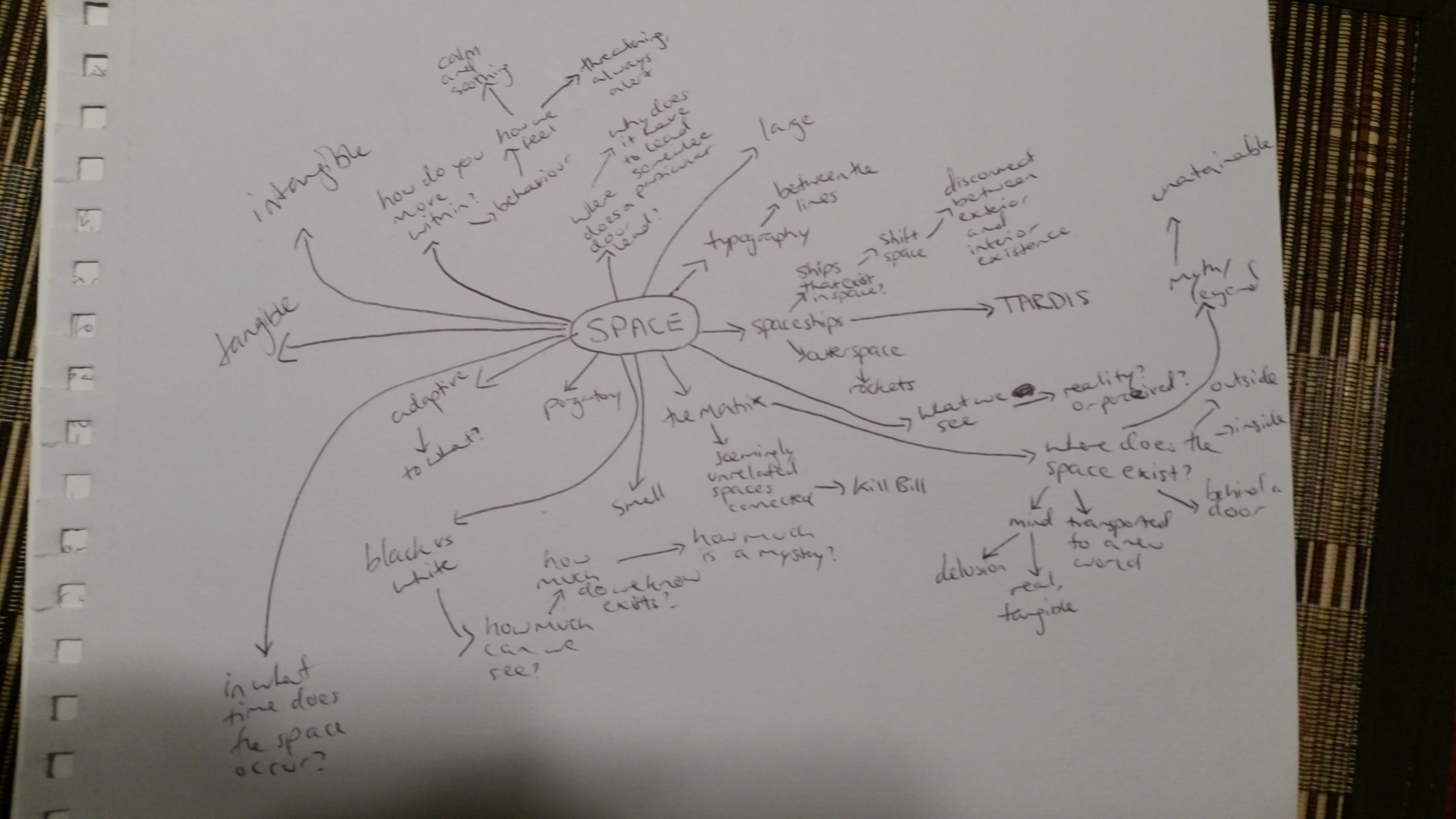For me, I find that there always seem to be too many possibilities, too many ideas to narrow in on one particular one. But more importantly, an idea I am attached to, something that I want to explore and develop, not simply an idea for a grade.
This meant getting every idea I had out on paper. Mind maps, I must admit, have always been dear friends to me. Through mind-mapping my ideas, I have found that the ideas I am least attached to, but would almost always inevitably come first, are put on the page and never really become a creative niggle again. I decided to create two mind maps. The first of which was centered around the idea of space:
Every ‘space’ I thought of was a world within itself. This, to me, was an exploration of the setting of whatever idea I chose. An exploration and freeing up of possibilities, the more abstract and absurd the better. In fact, the idea of a rocket in space was the final idea added to the mind map, as it didn’t feel right not having something so bleedingly obvious on there.
The thing I like the most about both of these mind maps is that there are infinite possibilities, an infinite number of ways each ‘space’ can be envisioned/mind-mapped and can create its own world with its own internal logic, culture, etc.
This is where I went off on a more precise track. An exploration of what I like and would want in a world:
This mind map distorts and dodges convention and realism at every turn. I have always been an absurdist at heart and this mind map really allowed me to realise that. In fact, the world I chose in the end was one of the examples I used on the mind map. It was originally the rules of the world that I came up with, that at a specified and unified time in the day, everyone on this street exits their houses and does something ridiculous. When pitching my idea to my table, that was when I inserted that they would all shout “hail Caesar”, but talking about it with my table made me realise that this act could be replaced with anything ridiculous and out of place and still work. This led me to a PSA that I have used in my previous work, in a found footage documentary by the same name:
This PSA is originally from 1951. It was used to control the emotions of the public in a dire time, when many were questioning their safety and the capability of the government to stop imminent nuclear bomb attacks. The ‘Duck and Cover’ technique was useless against a nuclear strike.
Because of the facade of this PSA, it has more dimensions than simply yelling “Hail Caesar”. Since the ultimate purpose of this PSA is to control the emotions of the public, it allows for this ‘propaganda town’ to take on more of a controlled internal logic, given the context of the “Duck and Cover” message.
I found myself inspired for this idea of a world (in which the internal logic seems to be that of reality with one simple twist), by many of my favourite films and writers, as the idea seemed to be reminiscent of their own works. From The Lobster (2015, Lanthimos), to Being John Malkovich (1999, Jonze) and Adaptation (2002, Jonze), each world has a strange, seemingly minor tweak to the logic of the film that allows the tiniest pull to unravel an entirely new and absurd plot.
I was also inspired by Franz Kafka and Samuel Beckett, both of whose works explore the way habits and social constructs affect how we live in different situations and determine our own internal working logic.
This idea is intensely political and has a clear agenda. For me, this is the only way to work. Just like blatant propaganda, everything we make is communicating a message, so you might as well communicate a message you want to be propagated. A message you would be proud to debate about. I want this film to promote critical thinking and awareness of messages being propagated to them every day. As this world is intended to critique human behaviour, but most importantly complacency and gullibility, I hope it will achieve this goal. Coming away from this film I want the audience to question their own internal logic and rules, and ask themselves, why.

